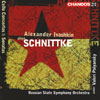Schnittke Cello Concertos and Sonatas
The definitive document of Alfred Schnittke’s relationship with the cello
View record and artist detailsRecord and Artist Details
Composer or Director: Alfred Schnittke
Label: Two for One
Magazine Review Date: 2/2008
Media Format: CD or Download
Media Runtime: 75
Mastering:
Stereo
DDD
Catalogue Number: CHAN241-39

Tracks:
| Composition | Artist Credit |
|---|---|
| Concerto for Cello and Orchestra No. 1 |
Alfred Schnittke, Composer
Alexander Ivashkin, Cello Alfred Schnittke, Composer Russian State Symphony Orchestra Valéri Polianski, Conductor |
| Sonata for Cello and Piano No. 1 |
Alfred Schnittke, Composer
Alexander Ivashkin, Cello Alfred Schnittke, Composer Irina Schnittke, Piano |
| Sonata for Cello and Piano No. 2 |
Alfred Schnittke, Composer
Alexander Ivashkin, Cello Alfred Schnittke, Composer Irina Schnittke, Piano |
| Concerto for Cello and Orchestra No. 2 |
Alfred Schnittke, Composer
Alexander Ivashkin, Cello Alfred Schnittke, Composer Russian State Symphony Orchestra Valéri Polianski, Conductor |
| Concerto Grosso No. 2 |
Alfred Schnittke, Composer
Alexander Ivashkin, Cello Alfred Schnittke, Composer Russian State Symphony Orchestra Tatjana Grindenko, Violin Valéri Polianski, Conductor |
Author: Philip_Clark
Schnittke’s Cello Concerto No 1 was written in the months after his first devastating stroke in 1985 and gives a grim portrayal of the composer’s psychological terror and disorientation, to the point where you start to empathise. Polystylistic jump-cuts, once the result of political repression, flip inwards as mournful intoning slams against
feral, expressionistic orchestral screams. Schnittke lays it on with a trowel, but his
genius for building dialectic tension between competing harmonies raises his argument
above the vanilla juxtapositions of lesser composers. When Schnittke returned home from hospital he had no memory of sketches he’d already made for his concerto – these narrative disjoints are painfully authentic.
The Concerto is one of Schnittke’s most recorded works, but it would be difficult to imagine a more physically committed performance than Alexander Ivashkin’s. The Cello Concerto No 2 was written in 1990 and is less in-your-face. A Viennese waltz that sounds like it’s been reharmonised by Berg briefly wanders into focus, hinting at Schnittke’s earlier compositional techniques. But “borrowed” reference-points are now more distilled, and the work spends 40 minutes amplifying and reinvestigating the implications of its opening moments, as the orchestra sits on the soloist’s attempts to generate more extended gestures.
Chandos has added Schnittke’s two cello sonatas to this reissued pairing of the concertos. No 1 is archetypal Schnittke, with grave slow opening and closing movements interrupted by the black humour of an intervening Scherzo, in this case characterised by dense tone clusters and bizarre pizzicato cello figurations. Impetus is turned on its head – progress gets increasingly staggered to create a kind of anti-momentum, a paradox that Ivashkin exploits keenly. The aphoristic Second Sonata is less imposing, and the “wrong-note” humour of the Concerto grosso No 2 is not the brand of Schnittke that appeals to me, but that’s neither here nor there – here’s the definitive document of Schnittke’s relationship with the cello.
The Concerto is one of Schnittke’s most recorded works, but it would be difficult to imagine a more physically committed performance than Alexander Ivashkin’s. The Cello Concerto No 2 was written in 1990 and is less in-your-face. A Viennese waltz that sounds like it’s been reharmonised by Berg briefly wanders into focus, hinting at Schnittke’s earlier compositional techniques. But “borrowed” reference-points are now more distilled, and the work spends 40 minutes amplifying and reinvestigating the implications of its opening moments, as the orchestra sits on the soloist’s attempts to generate more extended gestures.
Chandos has added Schnittke’s two cello sonatas to this reissued pairing of the concertos. No 1 is archetypal Schnittke, with grave slow opening and closing movements interrupted by the black humour of an intervening Scherzo, in this case characterised by dense tone clusters and bizarre pizzicato cello figurations. Impetus is turned on its head – progress gets increasingly staggered to create a kind of anti-momentum, a paradox that Ivashkin exploits keenly. The aphoristic Second Sonata is less imposing, and the “wrong-note” humour of the Concerto grosso No 2 is not the brand of Schnittke that appeals to me, but that’s neither here nor there – here’s the definitive document of Schnittke’s relationship with the cello.
Discover the world's largest classical music catalogue with Presto Music.

Gramophone Digital Club
- Digital Edition
- Digital Archive
- Reviews Database
- Full website access
From £8.75 / month
Subscribe
Gramophone Full Club
- Print Edition
- Digital Edition
- Digital Archive
- Reviews Database
- Full website access
From £11.00 / month
Subscribe
If you are a library, university or other organisation that would be interested in an institutional subscription to Gramophone please click here for further information.




